WEnRV travel news, products, and industry trends
Where to Roam in Wyoming
While being the country’s least populous state, what Wyoming lacks in people, it makes up for in natural wonders. With over 109 mountain ranges including 7 national parks and monuments, the state offers endless outdoor opportunities and the chance to explore some of the most breathtaking landscapes in North America.
Wind River Range
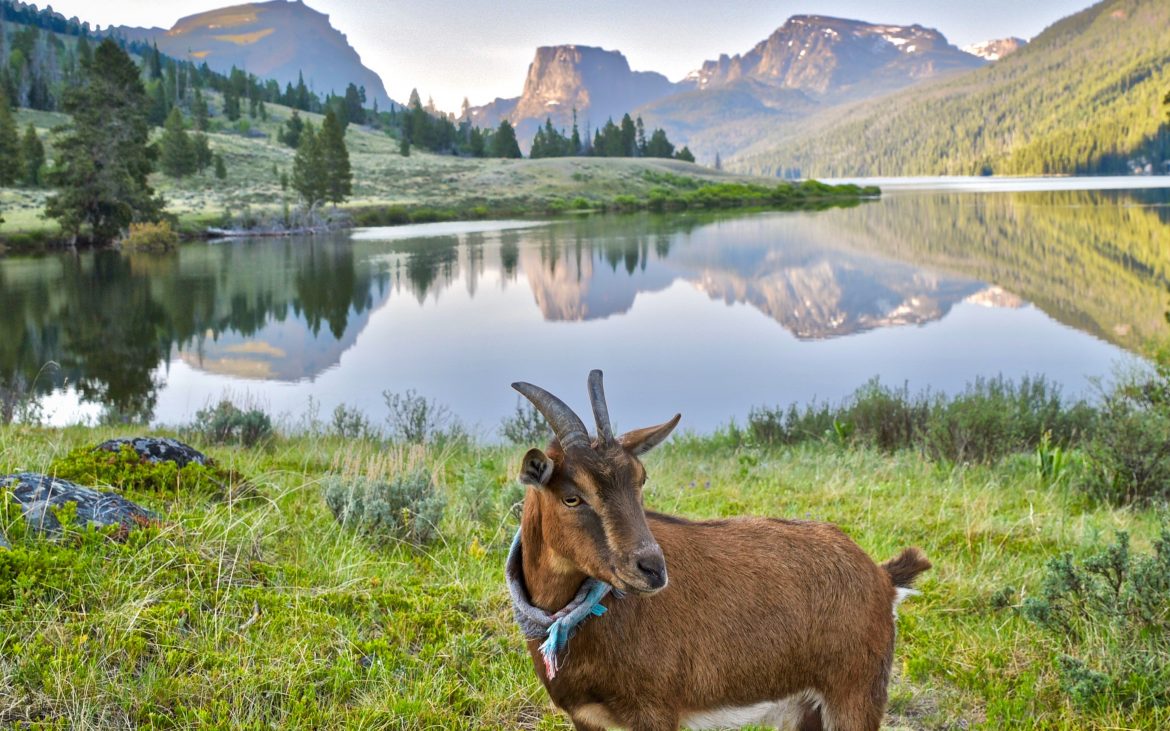
Frankie takes in the views of Square Top at Green River Lakes @CateBattles
Though one could easily assume the Tetons claimed the state’s highest mountain, the Wind River Range is actually home to over 40 peaks over 13,000 feet, including Wyoming’s tallest- Gannett Peak. Located in the west-central region of the state, the “Winds” follows the Great Continental Divide, featuring over 1,300 lakes and the single largest glacier in the American Rockies. Its remote wilderness encompasses an area of 2.25 million acres and provides 600 miles of trails that beckon outdoor enthusiasts.
While planning a visit to the Wind River Range, Pinedale serves as a perfect basecamp and your best bet to find supplies. In order to access this untamed land, be prepared for a 20 mile drive down a dirt road that takes every bit of two hours with a trailer. For those that don’t mind a little adventure, I can guarantee you every one of those washboards was worth the views you will be awarded once you reach Green River Lakes. Here, you’ll find the trailhead into the Bridger Wilderness and ample camping, between the national forest campground and dispersed sites along the gravel road. The majestic views of Square Top mountain, perhaps the most iconic of all the Wind’s peaks, can be seen from the campground as well as the remnants of several abandoned homesteads. Whether you’re looking for a day-hike or a multi-day trek, this is a great jumping off point into the Wind River Range. For an incredible and relatively easy day hike, take the 10-mile Highline Loop Trail that meanders along the shore, meadow, and forest. If you prefer a more strenuous backpacking adventure, take the 24-mile Cirque of the Towers Loop via the Big Sandy trailhead that showcases summer wildflowers, pristine lakes and rivers, and stunning views of glacially carved peaks.
Know Before You Go: Bring plenty of bug repellant and watch for seasonal snow.
Bighorn Canyon National Recreation Area
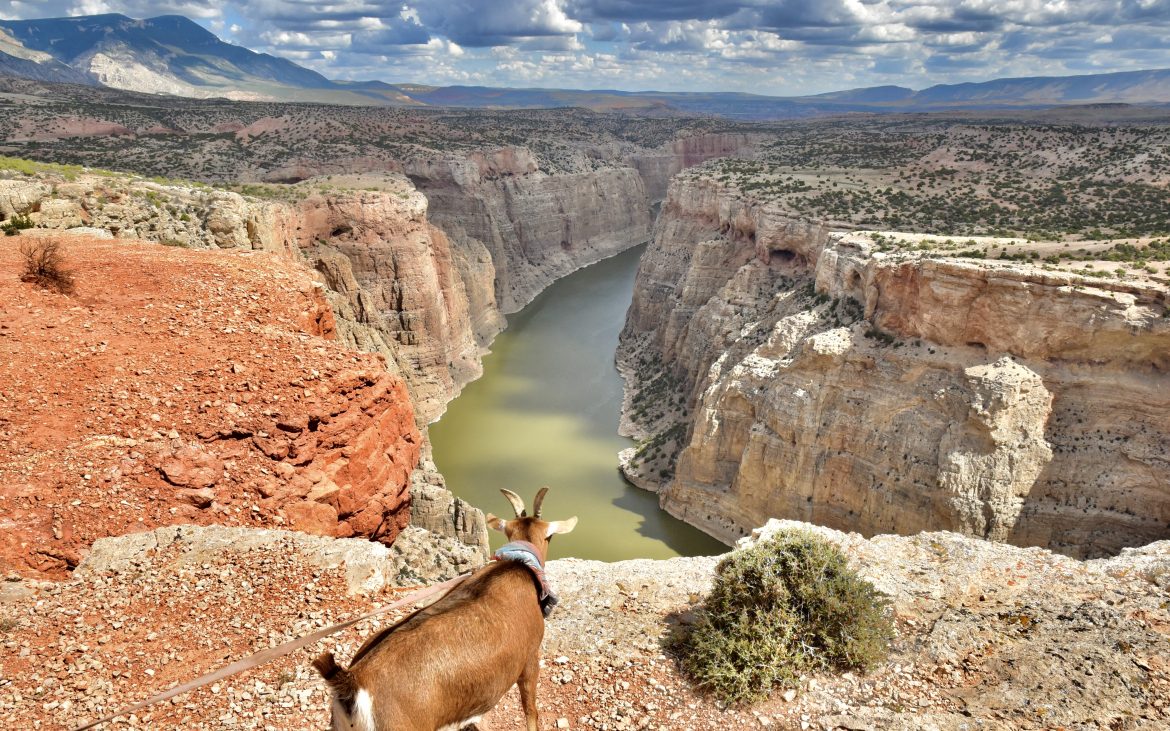
One of the best views can be found at Devils Canyon Overlook @CateBattles
Straddled along the Wyoming and Montana border is one of the state’s best-kept secrets. The Recreation Area was established shortly after the construction of Yellowtail Dam and today stretches over 60 miles, 55 of which traverses through the canyon. This colorful chasm exposes more than 570 million years of Earth’s history, including sediments laid down by volcanic forces and inland seas. At its deepest point, the canyon rises 2,500ft above the floor at Bull Elk Ridge. This region of Wyoming offers an array of landscapes from snow-capped mountains, desert, forest, prairie, and wetlands. Not only is the scenery diverse, but so is the wildlife. Here, you’ll have a chance to spot pronghorns, wild horses, bear, fox, and the park’s namesake… sheep. Additionally, the canyon is rich in indigenous history, as there’s evidence of human activity dating back 12,000 years. During the winter months, these early people would travel deep into the canyon and live in caves and rock shelters. In the summer months, they followed the animals up into the mountains to hunt and escape the summer heat. The best place to see signs of these early inhabitants is along the Bad Pass Trail where ancient cairns dot the sacred footpath.
While exploring Bighorn National Recreation Area, take the scenic drive up into the Bighorn Mountains outside of Lovell. The steep graded US14A whisks you up to 10,00ft in elevation, so it’s best to leave the trailer back at camp while exploring the high country. Along the drive, enjoy panoramic overlooks and make sure to visit the Bighorn Medicine Wheel, an ancient stone circle that was used to predict astronomical events. Down below, spend an afternoon on the lake fishing or kayaking or hike the many trails that follow the canyon rim.
Grand Teton National Park
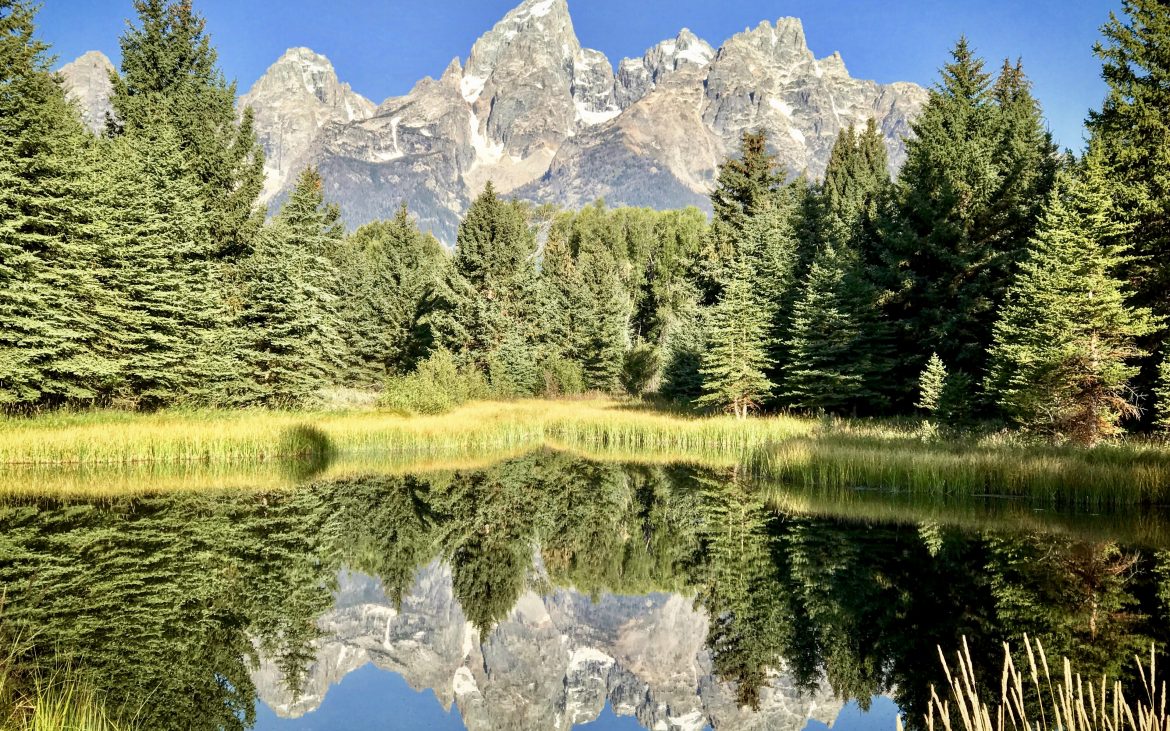
Teton reflections at Schwabacher Landing @Catebattles
Perhaps the most photogenic national park, the Grand Teton’s awe-inspiring beauty brings in visitors from all over the globe. Between the impressive views and legendary wildlife, this crown jewel of the West has so much to offer. Rising 7,000ft nearly vertically over the meandering Snake River and Jackson Hole Valley, the picturesque granite peaks are the youngest mountains in the Rockies. Often snow-capped well into July and home to several glaciers, these mountains are the heart of the 310,000 acres that encompass the national park. Situated along the Idaho border and just 7 miles south of Yellowstone’s boundary, the Tetons offer some of the best wildlife viewing in the country. While there, visitors have the chance to spot moose, bison, grizzlies, wolves, and over 300 species of birds. It’s also home to the National Elk Refuge, which provides sanctuary for one of the largest elk herds on Earth.
The best way to explore Grand Teton National Park is to visit in the late spring and early fall in order to avoid the summer crowds, otherwise, plan to start your days early from June to August. Some of the most photographed scenes of the park can be found at Oxbow Bend made famous by Ansel Adams and Schwabacher Landing, where alpenglow lights up the peaks during sunrise. Near Mormon Row, the iconic Moulton Barn was built by Mormon settlers in the early 20th century and is often regarded as the “most photographed barn in America”. For those who enjoy hiking, try the Cascade Canyon Trail, a 9 mile round-trip hike or the shorter Taggart Lake loop. Unfortunately, like most national parks, the trails are not pet-friendly, but there are fantastic Fido-friendly trails in the Bridger-Teton and Caribou-Targhee National Forests. For a day on the water, boat rentals are available at four different marinas or bring your fly rod and score some cutthroat trout for dinner. After an afternoon of adventuring, the town of Jackson has scores of restaurants, bars, boutiques, and art galleries to visit. If you happen to plan a trip during the winter, Jackson Hole Mountain Resort and Snow King Resort offer world-class skiing.
Stay: The Virginian Lodge and RV Park, Jackson, WY
Devils Tower National Monument

Devils Tower is an iconic landmark of the Wyoming prairie @CateBattles
Have a Close Encounter with one of the country’s most impressive monoliths, looming 1,000ft above the Black Hills of northeastern Wyoming. This striking natural landmark made of hexagonal columns is shrouded in mystery, as scientists are still trying to figure out how it was formed. Some geologists believe its the remnants of a volcanic plug while others are convinced it’s likely the remains of a laccolith; an intrusion of magma between two layers of sedimentary rock. Similar to basalt, the tower is comprised of rare igneous rock called phonolite porphyry and is the largest example of columnar jointing in the world.
Devils Tower got its name from Lt. Col. Richard Dodge in 1875, who led a scientific expedition into the Black Hills and believed the Native Americans called it “Bad God Tower”. However, it’s suspected that he received a poor translation and the native words for bear and bad god were confused. Known as Bear Lodge to many tribes including the Lakota, Cheyenne, Crow, Kiowa, and Arapahoe, this site has held sacred significance to native inhabitants for thousands of years. Though every tribe’s variation is different, the popular oral history passed down generation after generation tells of a group of girls that were chased by giant bears and climbed on top of a rock to escape the beasts. When they prayed to the Great Spirit to save them, the rock rose from the ground to the heavens and the bears left their claw marks in the rock.
While visiting the monument, there are 5 different trails that provide great views of the tower and the surrounding Belle Fourche River Valley. For those more daring, Devils Tower is a popular rock climbing destination, just be aware that climbing is closed in June to respect cultural ceremonies and in early April when falcons nest. Nearby, visit Fort Laramie and the adorable prairie dog town off of highway 110.
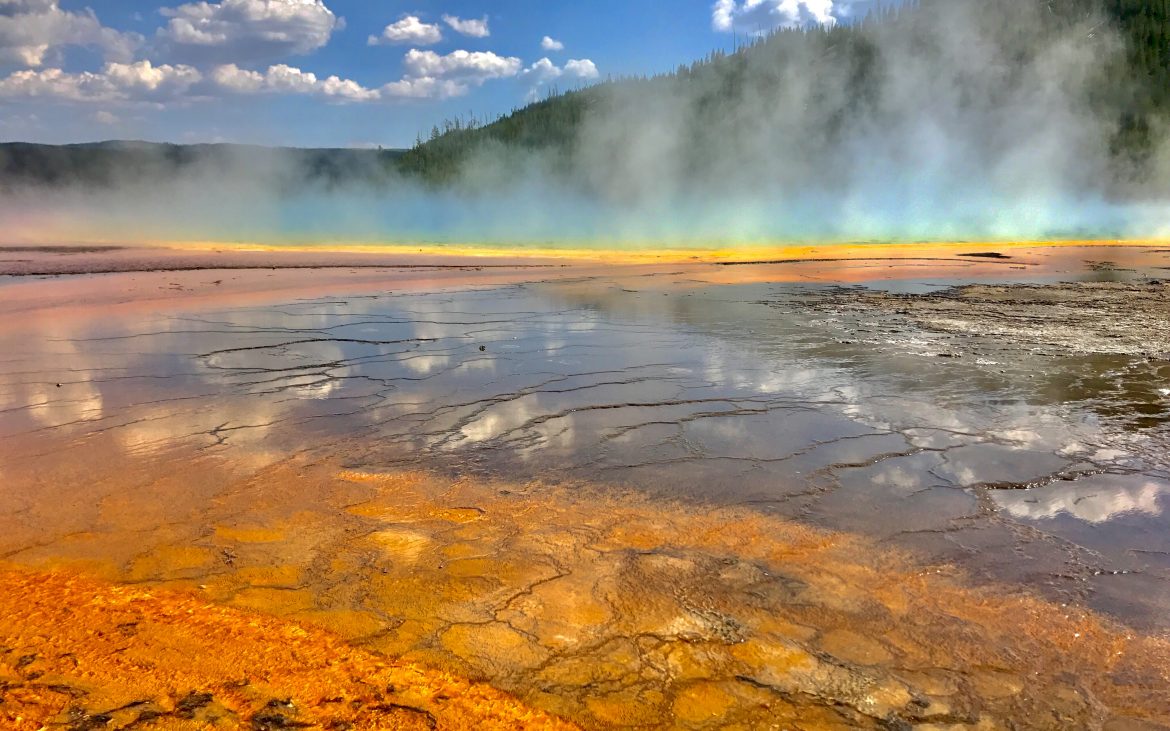
Grand Prismatic Spring is the 3rd largest hot spring in the world @CateBattles
It’s no wonder that Yellowstone is one of the country’s most visited parks. A few of its claims to fame include being the home to half of the world’s geysers, having the largest concentration of mammals in the Lower 48, and being the world’s first designated National Park. Established in 1872 by Ulysses S Grant, the park protects more than 2 million acres of mountain wilderness and the 10,000 geothermal features you see today.
Yellowstone is one of the world’s largest active volcanic systems and dates back 16.5 million years ago. Three major and catastrophic volcanic events took place within this time, the most recent being about 613,000 years ago when the Yellowstone caldera was formed. Today, the park sits on top of a chamber of scorching hot magma and this shallow source of heat is what fuels this geothermal activity. Some of the most iconic features in the park are Grand Prismatic Springs, Ol’ Faithful, and Artist Point where visitors are afforded spectacular views of the Yellowstone Canyon and falls.
To escape the crowds of the main park, take a day trip to the northern portion near Mammoth Hot Springs and enjoy the scenic drive around Grand Loop Road. While there, take a soak in the Boiling River- the only human safe hot spring in the park. Just be mindful of temporary closures due to high water levels. For your best chance of catching wildlife, head over to Lamar and Hayden Valleys. There, you’ll have a greater chance of witnessing the grizzlies, wolves, moose and bison that call Yellowstone home.
Stay: The Longhorn Ranch Lodge and RV Resort, Dubois, WY
Sinks Canyon State Park
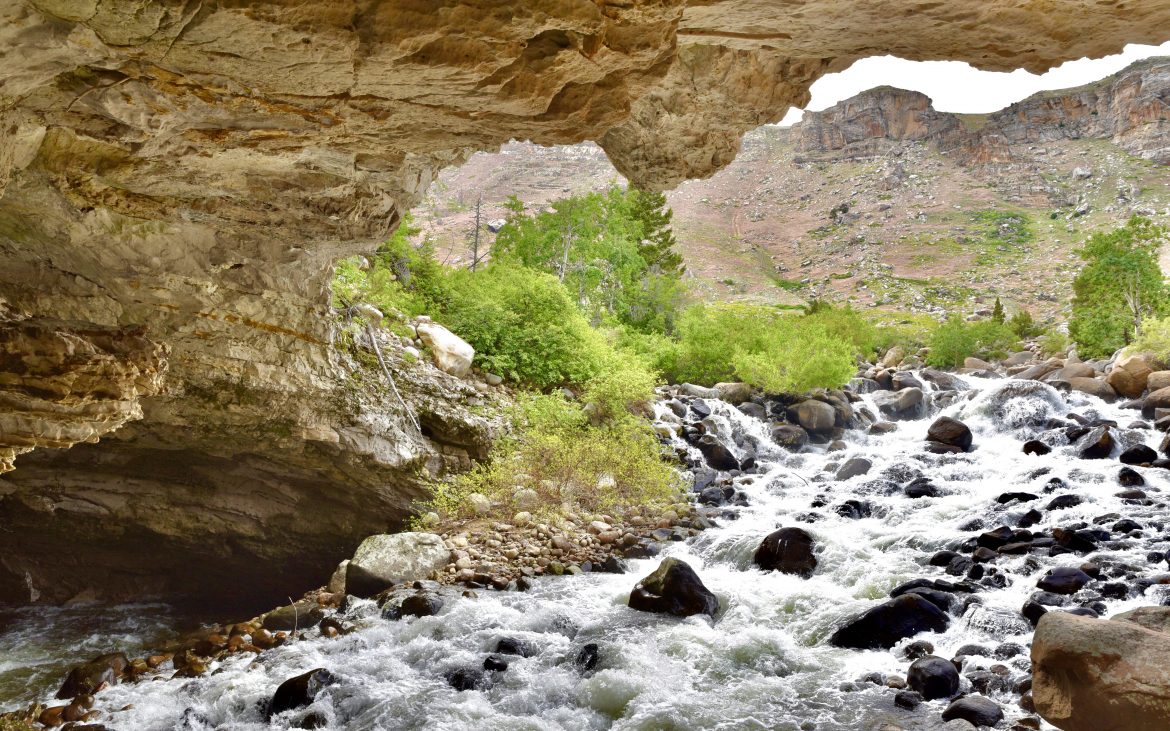
Chad and Frankie watch as the Popo Agie River disappears into the cave @CateBattles
Along the eastern slope of the Wind River Range and just outside of the outdoorsy town of Lander, you’ll find one of Wyoming’s neatest parks. Best of all, what you won’t find are the crowds! Sinks Canyon State Park is a rugged canyon that follows the Popo Agie River, and offers outdoor enthusiasts a wide range of activities, from hiking to world-class rock climbing. However, what makes this 600-acre park really unique are the incredible “Sinks” and “Rise” geological formations. At the Sinks, the river cascades down a set of rapids before disappearing into a limestone cave, only to re-emerge a half-mile down stream. Despite the short distance, the water takes nearly two hours to escape the cave and oddly enough, the amount of water exiting the Rise is considerably more than what enters the Sinks. This mystery has dumbfounded scientists, who still continue to study and learn more about this natural phenomenon.
While visiting Sinks Canyon, take the short pet-friendly trail starting at the Sinks where you can go inside the mouth of the cave and watch the river disappear. Afterwards, walk over to the Rise and watch the water escape into trout infested water. Here, you’ll spot hundreds, even thousands of trout from the observation deck above. During your visit at Sinks Canyon, continue on the Scenic Loop Road which takes you up into the mountains, passing several high elevation lakes and meadows scattered with wildflowers during the summer.
Beartooth Highway
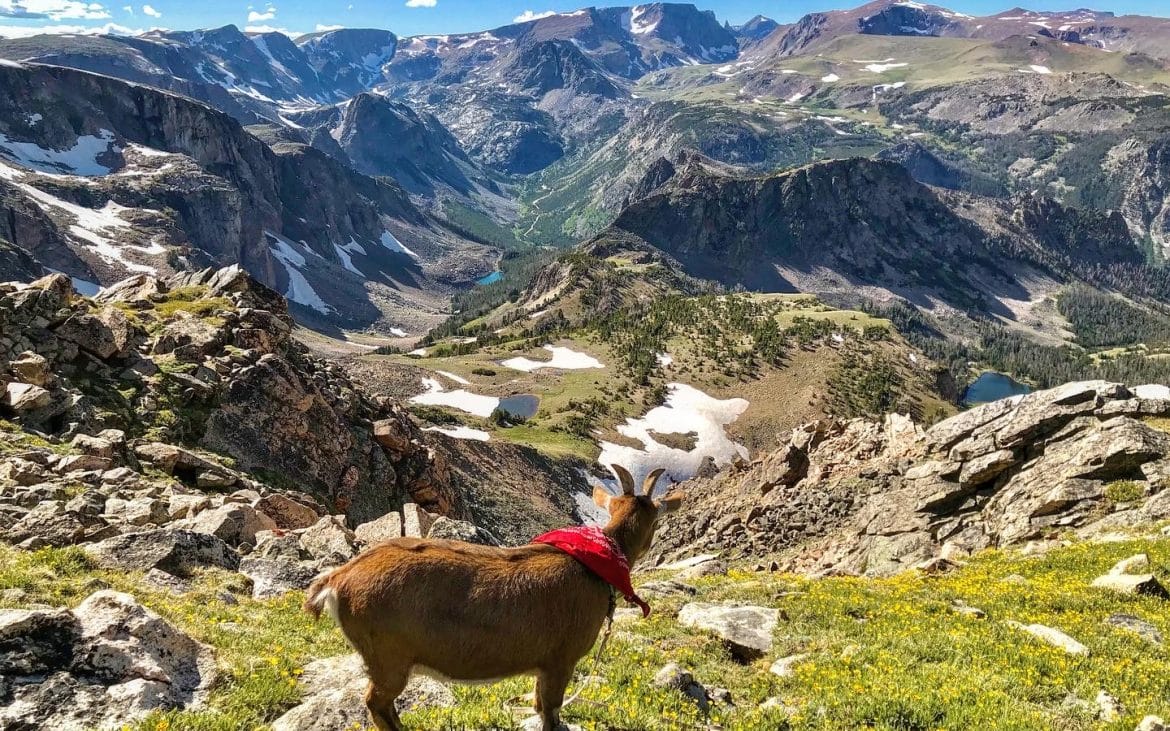
The Beartooth Highway is usually open Memorial Day through October but can still get a surprise snowstorm even in July @CateBattles
Elevate your senses by taking the 68-mile jaw-dropping journey along one of the most scenic drives in North America. The Beartooth Highway was built shortly after the gold rush and finished during the height of the Great Depression in 1936, as a road was needed to connect the mining town of Red Lodge with Yellowstone National Park. This winding mountain drive sweeps you up to 10,947 feet at the “Top of the World”, awarding visitors with panoramic views of the Absoroka-Beartooth Mountain Wilderness. With over 20 peaks over 12,000ft, the drive passes glaciers, pristine lakes, cascading waterfalls, and vibrant displays of wildflowers during the summer months. Views you typically could only get by backpacking up into the mountains can be witnessed without even leaving a car. Don’t be surprised to see mountain goats and bighorn sheep grazing just off the highway, as wildlife is abundant in this region. Additionally, bears, marmots, elk, and wolves call these mountains home.
Though it’s possible to do the entire drive in 3 hours, you can easily spend an entire day exploring. With dozens of hiking trails, endless vista points, and several lakes to stop and have a picnic, there’s no better place to relax and take your time.
The post Where to Roam in Wyoming appeared first on Good Sam Camping Blog.
Copyright
© Good Sam Camping Blog


